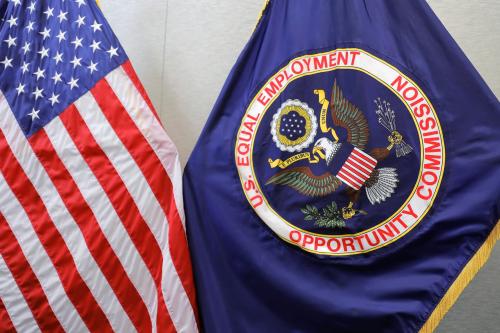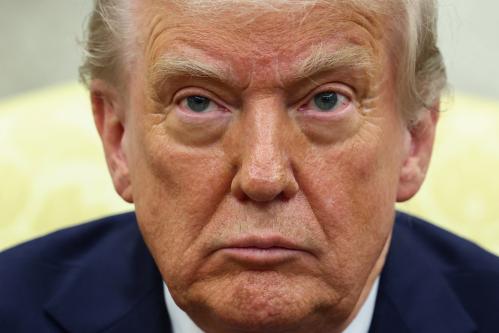We need to adjust the unemployment insurance tax base for wage growth – Brad Hershbein
 Brad Hershbein, Non-resident Fellow in Economic Studies at Brookings and an economist at the W.E. Upjohn Institute for Employment Research
Brad Hershbein, Non-resident Fellow in Economic Studies at Brookings and an economist at the W.E. Upjohn Institute for Employment Research
Unemployment insurance (UI) is supposed to be exactly that—a social insurance program, like Social Security or car insurance that workers pay into from their wages and in return receive a lifeline of benefits if they lose their job through no fault of their own.
The unprecedented job losses brought about by the COVID-19 pandemic have laid bare numerous shortcomings of UI, as others have written, but arguably the biggest fault of the federally guided, state-administered program is how severely underfunded it has become.
The problem has been decades in the making, as the federal minimum tax base on wages used to fund benefits and administration has been fixed at $7,000 since 1983. If the UI tax base had grown in line with the Social Security tax base, which is adjusted for growth every year, it would be $28,000 today. Because of this stagnation, after the Great Recession 36 states had to borrow more than $35 billion from the federal government to pay obligated benefits. Before the pandemic, 22 states had inadequate reserves to pay benefits, and as of February 2021, 19 states already owe the federal government $48 billion. To pay the bill, they will have to raise employer taxes, reduce benefits, or cut eligibility, all of which will slow the economic recovery and risk prolonged underemployment.
Adjusting the UI tax base for wage growth—as some states have already done—is one of numerous financing reforms needed. That’s why the W.E. Upjohn Institute for Employment Research is planning a convening of experts and stakeholders in April specifically on UI finance reform, with the goal of offering a blueprint to make the federal-state partner program stronger, more responsive, and better funded to meet the needs of all America’s workers.
Enhanced unemployment insurance is important for hospitality sector workers – Tracy Hadden Loh
 Tracy Hadden Loh, Fellow in the Anne T. and Robert M. Bass Center for Transformative Placemaking
Tracy Hadden Loh, Fellow in the Anne T. and Robert M. Bass Center for Transformative Placemaking
The January surge in unemployment claims, described by one analyst as “shocking,” was in fact predictable. In December 2020, accommodation and food services worker claims surged 672 percent from December 2019, the biggest jump of any sector and during a holiday month that is typically a major revenue generator for hospitality. In subsequent weekly reports in January and February, state-supplied comments to unemployment insurance (UI) claim data reported to the Department of Labor repeatedly noted accommodation and food services and the service industry. These months are traditionally the slowest for restaurants, and many are opting to close temporarily or permanently as the pandemic decimates their reserves and capacity to adapt.
Enhanced UI is important for workers in the hospitality sector, because standard UI is particularly engineered to fail them. These workers operate in the highest turnover sector in our economy and have among the lowest and most volatile earnings, which means that many workers collect only a pittance in (or are ineligible for) regular UI benefits. Workers from the hard-hit hospitality sector will fall into abject poverty and place an even greater burden on the social safety net if enhanced UI is not extended past the current expiration date.
Allowing this to happen would also dramatically worsen inequality across multiple dimensions. Women, young people, Black, and Latino or Hispanic Americans are overrepresented in the lowest-wage restaurant jobs. These populations of workers have thus been markedly harmed by the economic fallout of the pandemic. Moreover, the federal minimum wage for tipped workers has remained at $2.13 per hour since 1991, exacerbating the economic precarity of remaining workers in restaurants operating at reduced capacity. While the immediate solution is enhanced UI, raising the tipped minimum wage, combined with more relief for small business owners in hospitality, will be essential to preventing these workers from experiencing continued hardship and economic insecurity.
Failing to extend enhanced UI would result in increased COVID-19 transmission rates and a far greater cost to the public in terms of health and lives lost – Mallika Thomas
 Mallika Thomas, David M. Rubenstein Fellow in Economic Studies
Mallika Thomas, David M. Rubenstein Fellow in Economic Studies
While unemployment benefits are of great importance in terms of providing relief to individuals—allowing people to afford to pay their rent and buy food—it is becoming increasingly evident that we cannot reduce COVID-19 transmission rates without providing the financial ability for individuals to also act in the interest of the broader public good. As with a vaccine, the benefit of staying at home is far greater than the benefit to just the individual. The public benefits increase exponentially from each individual who can afford to turn down a job that would otherwise have increased community transmission rates.[1]
New economic research shows that the true cost to society of an individual becoming infected is more than three times the individual’s perceived cost. This undervaluation of the benefits of staying at home—and perhaps turning down a risky job in order to do so—has stark implications for how society ultimately overcomes the disease while valuing the economic tradeoffs. Without expanded unemployment benefits, individuals are unable to sufficiently take on what is ultimately a very expensive action (i.e., turning down a risky job) in order to produce what is, in large part, a public good.[2]
If workers are reluctant to consider job vacancies due to concerns about their personal health or safety, as indeed new evidence on job vacancies shows, recent analysis shows that this concern is justified. Moreover, because individuals tend to underestimate the benefit to society of staying at home—even taking into account the benefits to the economy of working—we should, in fact, be offering an incentive to make it affordable for additional workers to turn down work that would otherwise increase transmission rates. The only way to maximize social welfare is to incentivize the behavior that is the most valuable at this time to the American public—and that is an additional push toward staying out of jobs that continue to have significantly high rates of transmission and staying at home, even if some of those job vacancies go unfilled for a few more months.
—–
1. As shown in a more in-depth analysis of the incentives provided by unemployment benefits, a pandemic necessitates a large expansion of unemployment benefits beyond simply covering lost wages and income in order to allow individuals to make the decisions that are in the interest of the greatest social good.
2. Mallika Thomas, “Ways to Redesign Unemployment Benefits,” in Reopening America: How to Save Lives and Livelihoods, John R. Allen and Darrell M. West, eds., The Brookings Institution, May 2020, pp. 39-42.
It’s time to bring our safety nets into the 21st century – Annelies Goger
 Annelies Goger,David M. Rubenstein Fellow in the Metropolitan Policy Program
Annelies Goger,David M. Rubenstein Fellow in the Metropolitan Policy Program
Unemployment insurance (UI) is our safety net for workers who lose their job through no fault of their own. Experts have long sounded the alarm about how antiquated UI has become after decades of disinvestment and how it excludes many workers. The CARES Act of March 2020 created three new UI programs to expand coverage early in the pandemic, but rewriting rules in the midst of crisis made it even more difficult for states to get relief out quickly.
Expanded UI benefits played a critical role in stabilizing the 2020 economy and did not result in an overhyped “work disincentive.” Nevertheless, states continue to struggle with backlogs and cyber-fraud attacks. Vast differences across states in UI operation and the sheer volume of ongoing claims have thwarted state efforts to implement UI relief. We continue to see low coverage and major racial and gender disparities in access. Workers remain confused about who qualifies for UI and frustrated by unintelligible applications.
Rather than trying to fix 53 separate state UI systems, we should build toward a more efficient and equitable system nationally with three priorities:
1. standardizing and enhancing UI across states for more consistent, adequate, and equitable access;
2. establishing sustainable funding for UI and for continuously improving technological infrastructure and staff capacity; and
3. transforming UI management, IT procurement, and eligibility processes to build an accessible process for the end user.
We can also choose to automate and enhance how employers report wage record information, which would reduce the paperwork burden on them while enabling employers to initiate UI claims electronically when laying off workers or reducing hours. This would speed the process of getting relief to displaced workers tremendously and take an immense administrative burden off states. Building a more robust UI safety net with automatic triggers and updated technology and processes is essential for stabilizing a distressed economy and restoring the public’s faith in government.
On both humanitarian and economic grounds, it makes sense to extend unemployment relief – Gary Burtless
 Gary Burtless, Senior Fellow in Economic Studies and the Future of the Middle Class Initiative
Gary Burtless, Senior Fellow in Economic Studies and the Future of the Middle Class Initiative
In the middle of March 2021, special unemployment insurance (UI) programs established at the beginning of the COVID-19 emergency will begin to wind down. These UI programs once topped up workers’ regular UI benefits by $600 a week and gave laid-off workers an extra 13 weeks of benefits. In addition, another program broadened the number of laid-off workers eligible to collect unemployment benefits.
In comparison to the UI available in previous downturns, the temporary UI measures adopted in this recession were extraordinarily generous. This generosity permitted laid-off workers to pay all their pre-layoff bills and even to add to their saving. The available evidence suggests workers’ weekly consumption dropped sharply soon after they suffered a layoff, but it quickly rebounded after their UI benefits began. These workers’ spending provided income to other workers and their employers, and it helped the economy to recover.
One of the most generous UI provisions came to an end last July. Jobless workers with meager incomes soon began to cut spending. Some could not afford to pay rent or utility bills. In late December, Congress finally agreed to a package of UI measures that boosted weekly benefits and kept the eligibility extensions on track. The compromise allowed UI benefit liberalization to resume, but only through mid-March.
Winding down the benefit improvements would be fine if the labor market were fully healed. It is not. At the end of January, more than 19 million jobless workers were still collecting UI. All of them will receive much smaller checks and many will exhaust their benefits unless Congress acts soon. Allowing UI benefits to fall will threaten the ability of many workers to pay their bills. Reductions in their spending will hurt the business and job prospects of workers who remain employed. On both humanitarian and economic grounds, it makes more sense to extend UI relief to jobless workers than it does to top up the incomes of Americans who have remained healthy and comfortably employed.
Looming deadlines can help Congress reach deals – Molly E. Reynolds
 Molly E. Reynolds, Senior Fellow in Governance Studies
Molly E. Reynolds, Senior Fellow in Governance Studies
In the contemporary Congress, legislative deal-making is often driven by a deadline; the past decade-plus, for example, is littered with examples of cliffs and expirations producing last-minute deals. The logic of why this often works is straightforward: forced with extremely high costs of inaction—like a partial government shutdown—members of Congress are sometimes forced to reach compromises that they wouldn’t otherwise make.
Congress’s deadline-driven legislating muscles may be well-developed at this point, but they may not work as well for the supplemental unemployment insurance originally provided for by the March 2020 CARES Act as for other issues. In particular, states need time to actually implement an extension of the benefits, including by reprogramming systems and applying any changes in eligibility rules. Unlike avoiding a government shutdown, where the switch can be turned back on right up until—or, often, even in the hours right afterward—the deadline with relatively limited direct effects on beneficiaries, extending supplemental unemployment insurance benefits requires lead time to ensure an uninterrupted flow of benefits.
A second challenge arises from the legislative strategy congressional Democrats are deploying. To circumvent the possibility of a filibuster in the Senate, Democrats are using the budget reconciliation process to move a very large (up to $1.9 trillion) legislative package that seeks to accomplish a wide range of policy goals. Including the unemployment insurance extension in this bill may ease its passage by relieving proponents of having to build a 60-vote coalition in the Senate in support of a standalone measure, but requires the House and Senate to resolve many other policy and procedural differences relatively quickly for legislation of this size.
There are political benefits to extending unemployment insurance – John Hudak
 John Hudak, Deputy Director of the Center for Effective Public Management and Senior Fellow in Governance Studies
John Hudak, Deputy Director of the Center for Effective Public Management and Senior Fellow in Governance Studies
Extending enhanced unemployment insurance (UI) for Americans suffering from the labor market effects of the COVID-19-induced recession has visible and unseen political benefits for members of Congress and the president. Members of both parties recognize that many Americans are suffering as businesses across the country have faced permanent closures, have been unable to reopen anywhere near capacity or at all, and such closures have had ripple effects through the labor market.
Those labor market challenges are not restricted geographically or demographically, although certain areas and groups such as women, Blacks, and Latinos have suffered disproportionately. Every House member and senator has thousands of constituents who are suffering job losses—direct support for those individuals is necessary to support their children, pay bills, and survive. Although the cost of the enhanced UI is not trivial, the benefits will be diffuse, allowing legislators across the spectrum of political ideology to claim credit. At the same time, that infusion of money will almost entirely be spent immediately, contributing to greater economic benefit across a variety of industries that allow them to stabilize their own businesses and possibly create jobs.
There are unseen benefits to extending enhanced UI as well. Such an extension will allow elected officials to forego “the costs of doing nothing.” That is, if elected officials were to leave behind people facing unemployment, these officials would pay the political price of housing losses and displacement, bill defaults, generalized discontent, and the variety of personal, economic, and social challenges that will come from greater economic suffering. The prospect of a loss of votes should not be the sole motivator behind helping people in serious economic need. However, the reality of our politics today is that electoral fortunes are a greater motivation for many elected officials than is human suffering.



















Commentary
Around the Halls: Should Congress extend enhanced unemployment compensation?
February 24, 2021